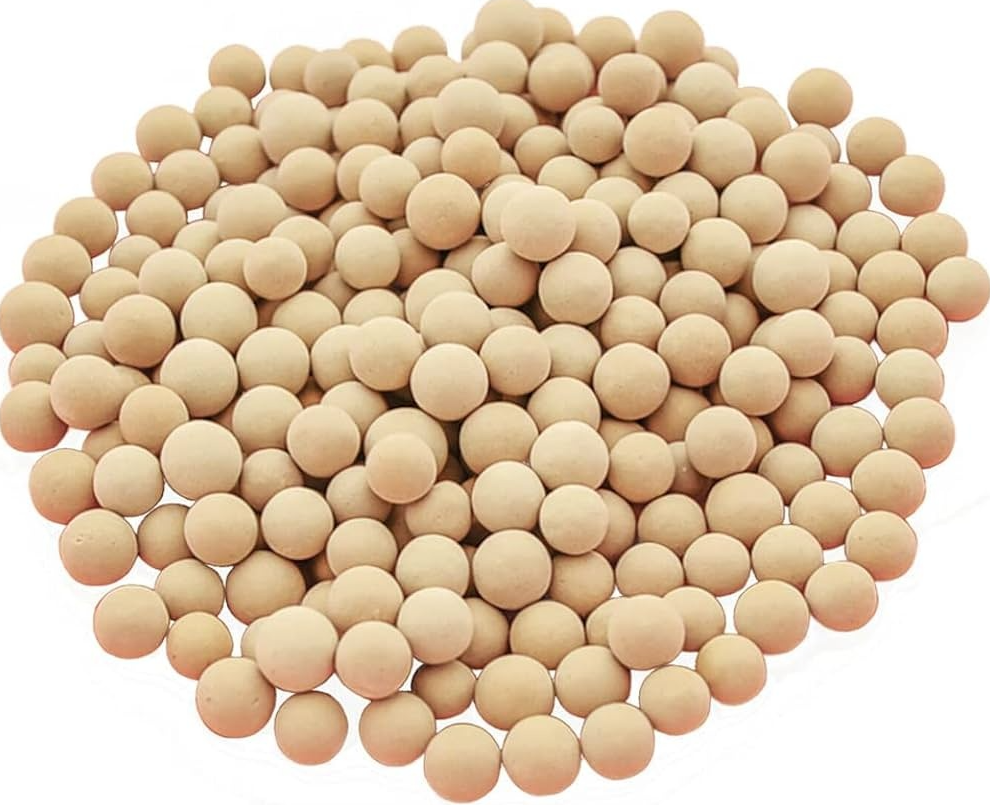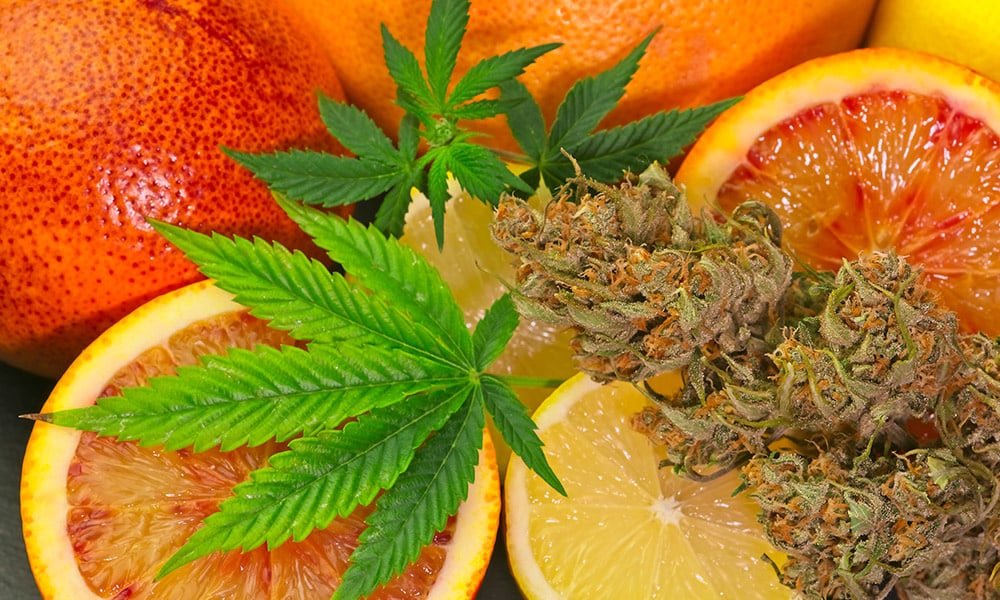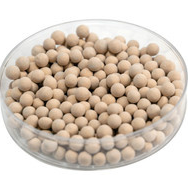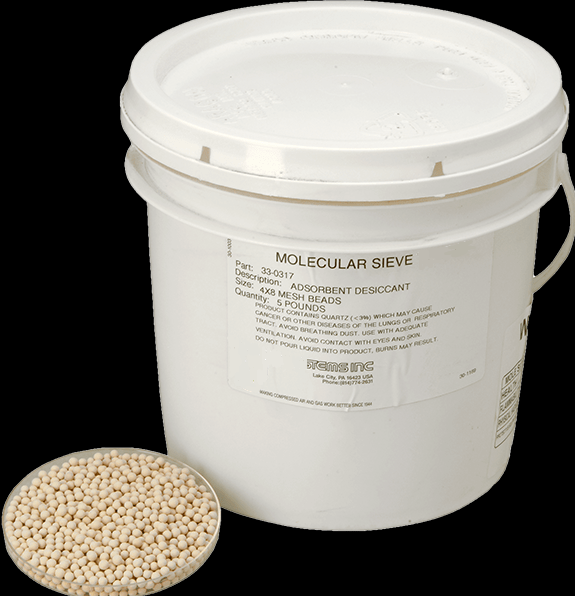You have no items in your shopping cart
What Are Molecular Sieve Beads and How They Work?
- Posted on
- 0

Discover everything there is to know about molecular sieves. What they are, how they work, and how they can help absorb moisture and maintain product quality.
Molecular sieves
Are commonly used to remove specific molecular compounds based on their pore diameter. Essential in various industrial processes in the petrochemical industry, pharmaceutical, air separation, gas purification, food and beverage, environmental, automotive, electronics, and energy storage and conversion to selectively adsorb, separate, and purify gases and liquids. Molecular sieves come in other shapes like pellets, but spherical beads are most common and have advantages such as lower pressure drop and higher crushing strength.

3A molecular sieve pictured
Each type of molecular sieve is divided into its own pore size and application. A molecular sieve is made of crystalline aluminosilicate that has a uniform pore size and structure to create a crystalline lattice. The crystalline lattice forms an exclusion barrier which prevents larger molecules from entering while allowing smaller molecules to enter and be absorbed. Pore diameters are often expressed as the number of angstroms. 10 Angstroms= 1 nanometer
The microporous structures have pores with diameters less than 20A, and while macro-porous structures have diameters greater than 500A, the mesoporous category covers the middle ground with pore diameters between 20A and 500A. The different size holes determine the molecules adsorbed.
The different pore sizes are created by swapping out cations (positive ions) in the chemical makeup of the crystalline structure. This creates larger or smaller pores in a very organized crystalline structure, which allows small molecules to pass by while adsorbing larger molecules through an ion exchange. This is how a molecular sieve is used to remove specific compounds from a solution as long as the molecules critical diameter matches the tiny pores of the molecular sieve.

3A Molecular Sieve
Molecular sieves sized 3A have a bulk density between 0.6 and 0.68 g/ml with a pore size of 3 angstroms which allows smaller molecules to pass through. Used heavily in the oil and petroleum industries to dry petroleum streams and natural gas. Using the high adsorbent properties of sieve beads, this size of desiccant is commonly used to absorb polar molecules such as water and methanol, but is more selective for smaller molecule sizes than 4A. Can also be used to remove moisture from the air, ethanol, and insulated glass.
4A Molecular Sieve
4A Molecular sieve have pore diameters close to 4 Angstroms, which allow molecules smaller than 4A to pass through and be absorbed. Commonly used to absorb water molecules, carbon dioxide, ammonia, ammonium ions, sulfur dioxide, hydrogen sulfide, ethane, ethylene, and sulfur compounds in petroleum and chemical industries where contaminants need to be efficiently removed without the use of another medium or process. Such as re-proofing alcohol by removing water content and thus raising the alcohol percentage.
5A Molecular Sieve
5A molecular sieve can adsorb molecules smaller than 5A. There is overlap in the use and applications of 3A, 4A, and 5A with each being optimal to specific use cases. 5A molecular sieve beads are commonly used to adsorb C3 and C4 n- chain alkanes, ethyl chloride, ethyl bromide, sulfur, CO2, and butanol. Some of 5A molecular sieve’s applications include natural gas drying, petroleum dewaxing, separation of N chained hydrocarbons from branched and cyclic hydrocarbons, desulfurization of petroleum and natural gas streams, pressure swing absorption, and separation of oxygen and nitrogen from air streams for oxygen production systems and scuba diving regenerative breathing apparatuses.

Sieve Beads for the Cannabis Industry
10A (13x) Sieve
In recent years, the cannabis industry has become a top consumer of Molecular Sieve beads for cannabis oil extraction purposes. When performing an extraction of plant material or winterization of an extract, using the hydrocarbon gas or alcohol will pick up quite a bit of water as it is used. As water builds up in the solvent, issues begin to build up as well. Hydrocarbon gas is often chilled in this process, and if there are significant amounts of water in the gas, the water will freeze and clog up important hoses. Also, the solvent loses its effectiveness, and water can contaminate end products if not removed. Too much water in the finished product leads to decreased shelf life, off flavors, and spattering when heated. Ethanol can also pickup water during the extraction or winterization/dewaxing process. The water hydrogen bonds with the alcohol and substantially changes the aggressiveness of the alcohol. While some water can be favorable typically alcohol around 90% works best. At 90% it can precipitate waxes without losing much cannabinoids and will dissolve the cannabinoids in an extraction process without dissolving too much chlorophyll. Typically, operators reduce alcohol temperatures to avoid chlorophyll in their extraction. A small drop in alcohol percentage can reduce the temperature required to achieve this which leads to perpetual savings from lost energy cost and speed up production. Molecular sieves are the most cost-effective method to maintain the correct percentage on water, or remove it all together. For water remove we recommend our 4A molecular sieves.
Molecular sieve beads can also be used to remove sulfides and contaminants from the Hydrocarbon gases before they are used for extraction. Typical distillation of the gases does not remove molecules of similar molecular weight while molecular sieves can further purify the gases without added much cost or complexity. This not only creates a clean finished product it also allows the gas to be used continuously while maintaining a consistency with extraction parameters. For hydrocarbon purification we recommend our 10A molecular sieves
Can a molecular sieve be reused?
Molecular sieves can be reused but will eventually become saturated. The beads can be regenerated but requires the beads to be placed under vacuum and heated to 350 to 600°F. This process may need to be repeated. This is typically too time consuming and costly in comparison to the low cost of buying new sieve beads. However, in some application where the beads cannot be easily accessed, or are hard to remove regeneration might be the only available option to continue using the beads.

Can I test to see how much life the molecular sieve has left?
Molecular sieves, especially 4A sieves used for water absorption will heat up when used. This is a good test to see how much water has been absorbed and thus how much life is left before saturation.
Pour 30ml of water into a small glass beaker or graduated cylinder. Determine and record the temperature of the water using a thermometer. Into a similar dry glass, pour a quantity of desiccant that is 10% greater by volume than the water (33ml). Dry the thermometer and place it into the glass containing molecular sieve. Quickly pour the water into the glass of
desiccant. Observe the increase in temperature of the mixture while stirring with the
thermometer and record the maximum temperature. This should occur in about 30 seconds.
Subtract the initial water temperature from maximum temperature observed. If the temperature
difference is 40°F/22°C or greater, the sieve is in satisfactory condition.
A simpler test is to weigh a small sample of the dry sieve beads and place into water and leave for up to 24hrs. Remove the beads, dry their outside with a towel, and reweigh them. The difference in percentage of weight from dry to saturated reveals the expected life of the beads remaining with 0% being saturated and 20+% being dry.
How Much Water Can Molecular Sieve Beads Hold?
Factors such as temperature, humidity, and pore size decide how much water any given sieve beads can hold. A general rule of thumb is that sieve beads will adsorb a little more than 20% of their weight in water.

How to Store Molecular Sieve Beads
Sieve beads are best stored in air tight containers away from any source of heat or humidity. Temperatures should be around 60°F to 80°F with humidity levels between 0 and 70%.
How to Choose the Right Molecular Sieve Beads
Consider the type of molecule you would like adsorbed, purity of your end product, and operating conditions. Select a sieve with slightly larger pores than the molecule you are aiming to remove, this will better allow the contaminate to be adsorbed without causing any blocking. Make sure operating temperatures are ideal for your sieve, some sieves are better for cold and others are not.
Goldleaf can help select the correct sieve beads if you are not sure which you need. Call or email any time and we would be happy to assist.
For any additional questions or inquiries please feel free to reach out to Goldeaf directly.
Phone: (510)487-1390
Email: sales@goldleaflabs.com


Comments
Be the first to comment...